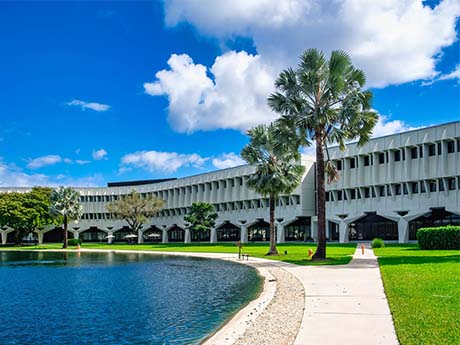By Brett Reese of CP Group
After several years of disruption, the office market is beginning to show meaningful signs of recovery. Market fundamentals are strengthening, sentiment is shifting and the data backs it up. Office sales totaled $64.3 billion last year, up nearly 21 percent from 2023, according to MSCI Real Assets.

Net absorption also turned positive, with 6.5 million more square feet of U.S. office space leased than vacated, marking the most substantial annual gains since 2019.
Rent growth has been substantial across key markets, lenders are re-engaging and marquee transactions are driving capital back to the sector. These are the first broad signs that the innovative strategies employed by experienced owners and operators over the past five years are beginning to pay off.
Sun Belt momentum
In Southeastern markets like South Florida and Atlanta, recovery outpaces national trends, driven by location, flexibility and amenitized space. Hard-learned lessons by tenants, lenders and landlords have reshaped the market. As the industry recalibrates, operators with conviction and capital can double down on what’s working.
Debt is returning
Perhaps the most significant harbinger of market recovery is the thawing of the debt markets. Just a year ago, lenders willing to underwrite office were few and far between. That tide is beginning to shift. We’re starting to see more activity, particularly in the commercial mortgage-backed securities (CMBS) space, which historically plays a vital role in funding institutional acquisitions and repositionings.
Private equity is also re-emerging. Where high-net-worth individuals once dominated deal flow, often operating without robust financing, more sophisticated capital is re-entering the fold as conviction returns and fundamentals stabilize.
Leasing velocity is up
Leasing activity across the country is the strongest it’s been since the pandemic began, a recent JLL report highlighted. As of January 2025, the office market has seen post-pandemic highs consecutively across the previous three quarters.
On the ground, leasing velocity is picking up steam. In Miami, every major submarket posted positive rent growth in early 2024, driven by consistent tenant demand for high-quality, mixed-use office environments driving steady gains. In Atlanta, average asking rents rose to $31.13 per square foot in fourth-quarter 2024, up 0.3 percent from the previous quarter, according to research from Partners.
Our own portfolio reflects this shift. Over the past six months, CP Group has signed more than 150,000 square feet across three of our downtown Miami projects — Miami Tower, One Downtown and Citigroup Center — and over 100,000 square feet in Atlanta’s Bank of America Plaza, bolstered by a large number of law firm tenants.
Even up in Charlotte, our three-office park Harris Corners has completed nearly 90,000 square feet in new deals in the past year.
Who’s benefitting?
The return to office has continued to reinforce a familiar post-pandemic theme: flight to quality. Tenants are gravitating toward well-located, fully amenitized buildings — those with spec suites, walkable dining, wellness offerings, lifestyle amenities and flexible space. The most successful owners are reimagining office as more like a destination than a workspace.
We have leaned into this approach. Our $100 million repositioning of Boca Raton Innovation Campus (BRiC) has transformed a historic IBM facility into a dynamic, community-first campus that is over 85 percent leased. In Atlanta, we are redeveloping the former CNN Center, introducing a new retail and entertainment hub while opening the office component to public leasing for the first time in 40 years.
Buildings that evolve to meet tenant and community needs will outperform in this next cycle.
Clear winners emerging
Not all assets are benefiting equally. Transitional or undercapitalized assets continue to face a steeper climb, with less liquidity and limited demand. Office owners unable to offer robust tenant improvement (TI) packages or modern amenities are struggling to compete. There is still a gap between the “haves” and “have-nots” when it comes to navigating the waters ahead, creating an opening for landlords with strong, amenitized offerings to capture tenants migrating from underperforming assets.
Part of South Florida’s rent growth recovery is a byproduct of the location and density of Class A offices in the city. In Miami, for example, the cost disparity between Brickell, which averages around $110 to $200 per square foot, is pushing more tenants to submarkets like downtown, which averages around $60 to $70 per square foot. We’ve seen a clear uptick in leasing velocity from tenants across our downtown Miami holdings for those seeking premier space at more accessible rates, signaling a broader flight-to-value trend within Class A assets.
Smooth sailing from here?
The worst may be behind us. Across the Sun Belt, institutional capital is re-engaging, leasing demand is returning and debt markets are showing signs of life. While macroeconomic variables remain in play, one thing is clear: the buildings that will lead the next chapter aren’t newer; they’re relevant for today’s workforce.
Those with flexible space, thoughtful amenities and investment capital will be positioned to capture demand as the office market stabilizes.
— Brett Reese is the partner and chief investment officer of Boca Raton, Fla.-based CP Group. Disclaimer from CP Group: This article was drafted prior to Trump’s tariffs, and we are seeing a negative impact real-time. The sentiments in this article are predicated on the tariffs being resolved within the next 90 days. Otherwise, these sentiments are no longer supported.


